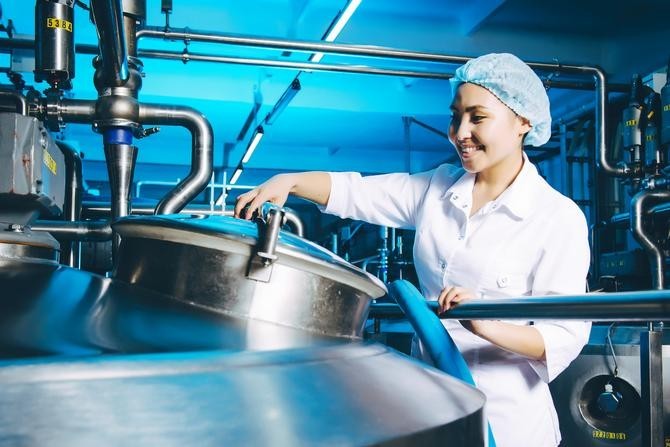Dairy production places extremely stringent quality requirements on equipment suppliers. This is directly related to the need to maintain exacting standards of cleanliness. The wide range of products made from milk translates into a multitude of processes carried out during their production. After all, milk is used to make such diverse products as cheese, butter, yogurt and powdered milk.

Among the processes that occur during dairy production are degassing, purification, storage (warehousing), heat treatment (such as pasteurisation), homogenisation, fermentation and many others. Each of these processes requires the use of appropriate machinery or complete installations.
Stainless steel manways are installed in many dairy equipment, but in particular in stainless steel tanks. Among them, there are two basic types:
storage tanks,
process tanks.
And although tanks and dairy machinery use manways of all available shapes, the predominant types of manways in the dairy industry are round manways and oval manways. Importantly, both non-pressure manways and pressure manways are applicable in milk processing . Dairy manway covers and the gaskets used in them meet the requirements of relevant standards, and Regulation 1935/2004/CE.
Vertical storage tanks are a distinctive sight in any dairy. These huge structures, which often reach a couple of meters in diameter, can store up to several hundred thousand litres of raw milk inside. A properly selected and located stainless steel manway is a must for this type of storage tank.
This is because the manway provides safe access to the inside of the tank for periodic inspection or repair. It also allows (depending on the design): filling, emptying, sampling, washing, as well as visual inspection of the contents (in the case of manways with a sight glass or glass cover installed).
Stainless steel oval manways are installed in the side shell of storage tanks, at a height that allows a person of average height easy and safe access. In most cases, these are pressure manways that open inward from the tank. Some models are equipped with a special arm and an attachment that allows the cover to be removed to the outside. A separate group are oval manways arched to the curvature of the tank shell, so that they form an almost uniform plane with it.
Round stainless steel manways in most cases are installed in the top head (roof) of the tank. Manways of this type are equipped (depending on the type and model) with covers:
Some models of round manways are designed to function properly and safely in the side shell of the tank. Such a manway can open towards the inside of the tank or towards the outside of the tank. In the case of outward-opening round side manways, the appropriately reinforced design of the hinge supporting the open cover and the multi-point pressure of the cover determine the durability and safety of the entire closing.
A large range of diameters from DN100 to DN1400 allows the round manway to be tailored according to needs and functions.
Process vessels are characterised by a huge variety. Their design, size, shape, capacity, equipment, unique functionalities – all these are subordinated to the process in which they participate. This group includes both non-pressure and pressure tanks, as well as insulated tanks, coolers, mixers, separators, buffer tanks and more.
This diversity translates into the need to use manways with widely varying pressure parameters, shapes, sizes and functional properties. The challenges are often high operating pressures, the presence of vacuum, and a wide temperature range of operating and ambient media. On top of all this, there are requirements to maintain cleanliness standards – CIP cleaning systems, use of cleaning agents and safety rules.
A sizeable group of processes involved in dairy production use non-pressure tanks. In most cases, the manways installed in these types of tanks are lightweight designs, with a single or two-point cover pressure.
Dairy, non-pressure manways are used, among other things, in milk cooling systems, as well as in special non-pressure mixing tanks. For processes requiring a more sophisticated temperature control system, they can also be used in thermally insulated tanks.
For the needs of the process itself, or for the operations and maintenance of the equipment, they use non-pressure manways that are round, oval or rectangular. Some process tanks are equipped with more than one manway. The number, size, shape and position of each manway in the tank are linked directly to the requirements of the manufacturing process itself.
The pressure processes that occur in dairy production require appropriate instrumentation and installation. Equipment used in this type of process is very often equipped with an inspection element in the form of a pressure manway. Unlike standard lightweight non-pressure manways, pressure manways have a design resistance of 0.5 bar to as much as 12 bar (depending on the version).
Pressure manways in the dairy industry are used, among other things:
Round top non-pressure manways are also an element of small dairy tankers. Manways of this type usually have a slightly longer mounting frame (approx. 90-150 mm). A distinctive feature of upper manways for dairy tankers is a convex, smooth and perpendicularly opening cover that does not retain water on its surface (even in adverse weather conditions). Closing the manways of dairy tankers is usually done by pressing a single handwheel or tightening a suitable clamp.
We use cookies